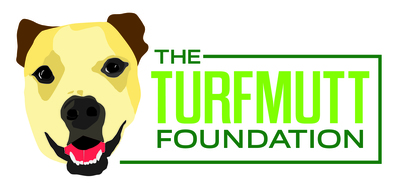July is National
Park & Recreation Month
ALEXANDRIA, Va.,
July 15,
2024 /PRNewswire/ -- For 15 years, the TurfMutt
Foundation has advocated for the care and use of parks, yards and
other green spaces. Neighborhood parks are community connectors,
and they offer a place for city dwellers and those without their
own at-home green spaces to practice the art of backyarding –
taking every day activities typically done inside, outside.
"Mulligan the TurfMutt and I love spending
time in our community park where we can meet up with our
neighbors"
"Mulligan the TurfMutt and I love spending time in our community
park where we can meet up with our neighbors, connect with nature,
and visit the dog park for some off-leash fun," said Kris Kiser, President & CEO of the TurfMutt
Foundation. "The benefits of green space are undeniable, and it
starts in our own parks and backyards."
In celebration of National Park & Recreation Month, the
TurfMutt Foundation shares these "superpowers" of parks:
Promotes Physical Health
Access to neighborhood
parks and green space is linked to higher activity levels in
children in Norway.
Researchers also found that people living near green spaces,
including parks or forests, age slower than those
in dense urban environments. Visits to parks, community gardens,
and other urban green spaces may lower city dwellers' use of
prescription drugs for anxiety, insomnia, depression, high
blood pressure, and asthma. Children aged four to six living near
parks, gardens, or fields have increased bone density,
according to a study conducted in Belgium.
Boosts Mental Well-being
A study of more than
8,000-middle aged and older adults in China concluded that the greenness and
proportion of public parks was related to a reduced risk of
loneliness. People who visited urban parks for just 21 minutes
showed a reduction in cortisol (stress hormone) levels and reported
increased overall well-being. Mental health and youth development
programs held at parks in Florida
for at-risk youth were shown to have the potential to prevent
violence among the kids. A longitudinal study of a park
prescription program for low-income families found that increased
visits to neighborhood parks significantly increased children's
resilience while decreasing their stress levels.
Creates Wildlife Corridors
Community parks combine
with the green space in our backyards and other verdant community
areas to create wildlife corridors that link together fragmented
habitats. Urban parks can also increase biodiversity. For instance,
researchers found that birds rely on both public parks and private
backyards in different seasons and for different reasons. Parks had
a higher biodiversity in the summer and housed more ecologically
rare species. Backyards had a higher bird abundance in the winter,
as well as more urban-tolerant species and more resident generalist
species.
Cools Heat Islands
Surrey's Global Center for Clean
Air Research in the UK quantified the effect of green space on
cooling urban areas. According to research: botanic gardens are 41
degrees cooler than their surroundings, green walls are 39 degrees
cooler, parks are 38 degrees cooler and playgrounds are 37 degrees
cooler. The bigger the green space, the bigger the benefits, and
linked green spaces compound the cooling effects. Large parks or
tracts of urban trees can cool daytime summer temperatures by
about 10 degrees. Shaded ground can be up to 36 degrees cooler than
unshaded ground.
To learn more about the many benefits of the green space around
us, download the TurfMutt Foundation's International Backyarding
Fact Book here.
For more, sign up for Mutt Mail, a monthly e-newsletter with
backyarding tips and all the news from the TurfMutt Foundation
here. To learn more about creating the yard of your dreams, visit
TurfMutt.com. Look for Mulligan the TurfMutt on the CBS Lucky
Dog television show on Saturday mornings.
Media contact
Debbi
Mayster, Four Leaf PR on behalf of the TurfMutt Foundation,
240-988-6243, debbi@fourleafpr.com
About TurfMutt
TurfMutt, which is celebrating its
15th anniversary in 2024, was created by the Outdoor
Power Equipment Institute's (OPEI) TurfMutt Foundation and has
reached more than 70 million children, educators and families since
2009. Championed by Foundation spokesdog, Mulligan the TurfMutt,
and through education partners such as Weekly Reader, Discovery
Education and Scholastic, TurfMutt has taught students and teachers
how to "save the planet, one yard at a time." Today, TurfMutt is an
official USGBC® Education Partner and part of their
global LEARNING LAB. TurfMutt has been an education resource at the
U.S. Department of Education's Green Ribbon Schools, the U.S.
Department of Energy, the U.S. Environmental Protection Agency,
Green Apple, the Center for Green Schools, the Outdoors Alliance
for Kids, the National Energy Education Development (NEED) project,
Climate Change Live, Petfinder and the U.S. Fish and Wildlife
Service. In 2017, the TurfMutt animated video series won the
coveted Cynopsis Kids Imagination Award for Best Interstitial
Series. TurfMutt's personal, home habitat was featured in the
2017-2020 Wildlife Habitat Council calendars. More information at
www.TurfMutt.com.

 View original content to download
multimedia:https://www.prnewswire.com/news-releases/the-turfmutt-foundation-shares-four-ways-community-parks-benefit-people--the-planet-302196560.html
View original content to download
multimedia:https://www.prnewswire.com/news-releases/the-turfmutt-foundation-shares-four-ways-community-parks-benefit-people--the-planet-302196560.html
SOURCE TurfMutt Foundation